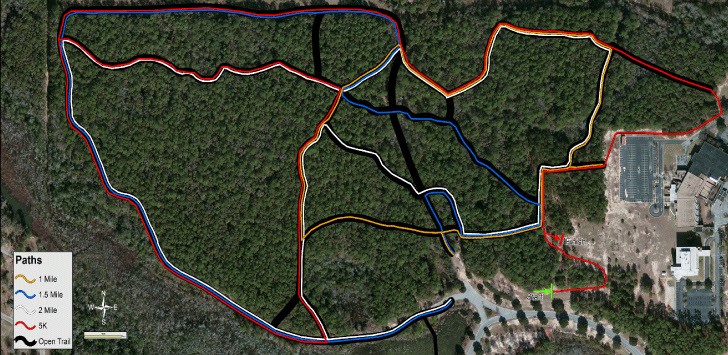
2 Aquatics Plants
30o42.020 N 88o11.078 W
 Aquatic plants like Water Lilies (Nymphaea odorata) and Goldenclub (Orontium aquaticum) colonize the lakes and wetlands on the USA campus. Water lilies can grow in water up to eight feet deep, while Goldenclub prefers shallow waters. Water Lily flowers open in the morning and close in the afternoon. They slowly change from white to pink over their 2-3 day life span. The water Lily plant is eaten by animals such as turtles and beavers. Goldenclub has a waxy film around their leaves which strongly repels water. It also has a starchy root that was eaten by Native Americans.
Aquatic plants like Water Lilies (Nymphaea odorata) and Goldenclub (Orontium aquaticum) colonize the lakes and wetlands on the USA campus. Water lilies can grow in water up to eight feet deep, while Goldenclub prefers shallow waters. Water Lily flowers open in the morning and close in the afternoon. They slowly change from white to pink over their 2-3 day life span. The water Lily plant is eaten by animals such as turtles and beavers. Goldenclub has a waxy film around their leaves which strongly repels water. It also has a starchy root that was eaten by Native Americans.
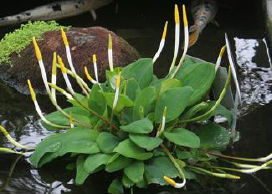
28 Japanese Climbing Fern Lygodium japonicum
30° 42. 203’ N 88° 10 . 923’ W
86802, 97326
The Japanese climbing fern is an exotic invasive vine-type fern, reaching up to 90 feet in length. Since its introduction, the fern has become something of a nuisance. It can create dense mats on the forest floor that will grow over native plants and choke them out, eliminating food sources. In extreme cases, the fern will completely engulf a forest to the point where the native plants are not even visible. The leaves are lacy and finely divided and arranged opposite on the vine. Tiny spores form on the underside of the leaves and are easily dispersed by wind. This fern is native to Asia and tropical Australia.
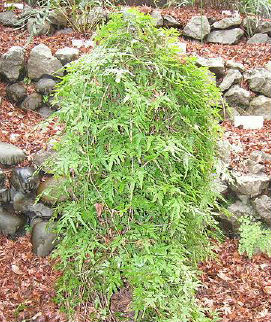
26 Resurrection Fern Pleopeltis polypodioides
30° 42. 244’ N 88° 10. 873’ W
86884, 97401
The Resurrection Fern is a native air plant that lives on the branches of trees. The fern can survive droughts by curling up and going dormant. After rain, it uncurls and becomes lush and green again, earning it the name of “resurrection fern.” The plant can lose over half of its water and still be able to become active again. As a comparison, most plants can only lose around 10% of their water. The fern gets nutrients from the air and rainwater that collects on the bark of the tree, not from the tree itself.
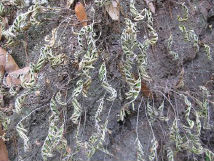
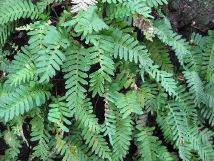
Dormant
Active
25 Gum Pounds
30° 42. 255’ N 88° 10. 878’ W
86875, 97422
Gum ponds are moist depressions where soils are usually clay-like and poorly drained. Because the soil is water-logged during rainy seasons, only trees that can tolerate saturated soil grow well in these depressions. The main tree found in this gum pond is the swamp tupelo. When trees grow in water-logged soil, their trunks are often swollen near the base. The swollen trunk, called a buttress, provides a more stable foundation to help hold the tree upright in the wet soil. Water-logged soils are difficult for plants to live in because there is no air in the soil. Think about what happens to a potted plant when the flowerpot’s drain hole gets plugged. Only a few trees can live in these conditions.
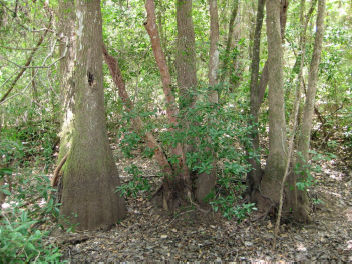
23 Snakes
30° 42. 261’ N 88°11 . 019’ W
86651, 97435
Snakes have a bad reputation and are often treated with fear and aggression. However, snakes are an important part of our ecosystem. An interesting adaptation that snakes have is molting. Molting occurs as snakes grow and shed their old skin to allow their new skin to grow. Keep a look out for snake skins on your hike. Although rarely seen, these snakes can be found throughout the nature trail.
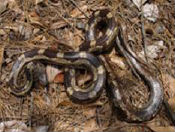
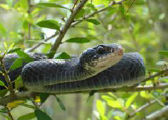
Grey Rat Snakes are harmless, good climber, and feed on rodents and birds
Black Racers are non-venomous and very fast
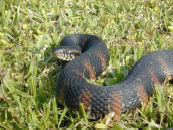
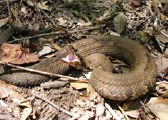
Banded Water Snakes are harmless and usually near the water
The Cottonmouth is an aggressive venomous snake known locally as a Water Moccasin
29 Cogan Grass Imperata cylindrica
30° 42. 167’ N 88° 10 . 985’ W
86703, 97261
Cogon Grass is a perennial exotic grass native to Asia. The grass is easily flammable even when visibly green. Despite this, the grass has been used to thatch roofs in traditional houses in Southeast Asia for generations. Cogon can grow 2–10 feet tall and spreads through its roots and seeds. Its leaves are wide near the base of the plant and narrow to a sharp point at the top with a distinct feathery seed head. Since Cogon grass is often found on roadsides, the effect of these seed heads blowing in the wind can be an interesting sight.
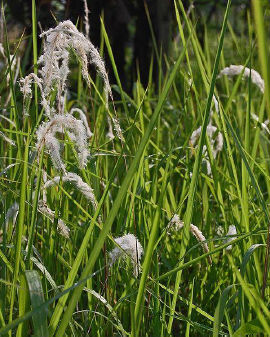
30 Three Southern Pines
30° 42. 123’ N 88°10 . 974’ W
86720, 97179
Longleaf Pine (Pinus palustris)
- Needles 8-18” long in clusters of 3 slender, flexible, drooping
- Cones are 6-10” long
- Bark is reddish brown and in plates
Slash pine (Pinus elliotii)
- Needles 7-11” long in clusters of two slender, flexible, twisting
- Cones are 3-6” long
- Bark is gray and scaly
Loblolly pine (Pinus taeda)
- Needles are 6-9” long in clusters of 3 slender, stiff
- Cones 3-6” long
- Bark is gray and scaly
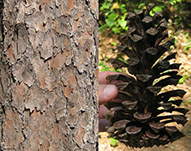
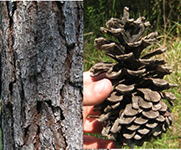
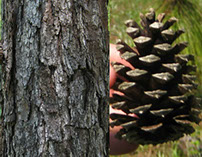
5 Yaupon Holly
30o42.019 N 88o11.211 W
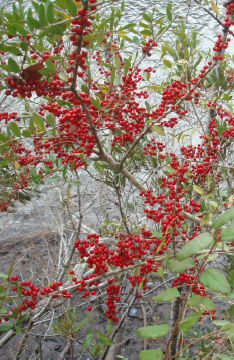 Yaupon Holly, nature’s Christmas decoration, is a shrub with bright red berries and small leathery leaves. In winter months, these berries are an important food source for many birds. The name, vomitoria, comes from the apparent use of the plant by Native Americans in a tea used to induce vomiting as part of cleansing rituals. The tea may not have been the culprit, but the negative name stuck. Only the female yaupons produce berries.
Yaupon Holly, nature’s Christmas decoration, is a shrub with bright red berries and small leathery leaves. In winter months, these berries are an important food source for many birds. The name, vomitoria, comes from the apparent use of the plant by Native Americans in a tea used to induce vomiting as part of cleansing rituals. The tea may not have been the culprit, but the negative name stuck. Only the female yaupons produce berries.
8 Vines, Vines, and More Vines
30° 42. 172’ N 88°11. 411’W
Vines are plentiful wherever rainfall is abundant. Common vines on the Nature Trail are Muscadine Grapes (Vities rotundifolia), Virginia Creeper (Vitis quinquefolia), and Poison Ivy ( Toxicodendron radicans). Poison Ivy has three leaflets and a hairy stem. This vine causes a severe itchy rash on almost anyone who touches it. “Leaves of three, let it be.” Virginia Creeper has 5 leaflets and is an important winter food source for birds. Muscadine Grape is found everywhere in the trail. Its leaves are single with distinct teeth on the edges. This grape can be used to make wine.
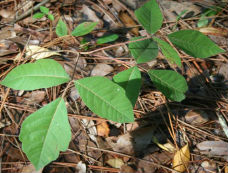
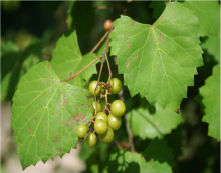
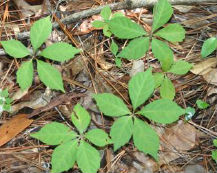
Poison Ivy
Muscadine Grape
Virginia Creeper
20 Tung Oil Tree Aleurites (aka Vernicia) fordii
30° 42. 300’ N 88° 11. 347’ W
86128, 97512
The Tung Oil Tree is a small invasive exotic tree native to China. Even though this tree is small, its leaves are some of the largest you will see on the trail. However, be sure not to touch them. All parts of this tree are toxic. The leaves can leave itchy rashes similar to poison ivy and consuming one nut can be fatal. The nuts yield an oil that is used in varnishes, paints, resins, and greases. The Tung Oil Tree appeared in the writings of Confucius around 400 BC and Marco Polo in the 13th Century.
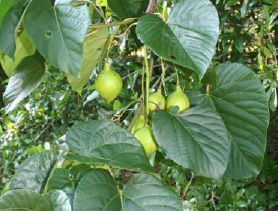

21 Exotic Plants
30° 42. 228’ N 88°11 . 118’ W
86493, 97487
An exotic plant is a species not native to the area that has been introduced for a variety of reasons. Many exotic plants have adapted to their new environment without harming it. However, exotic invasive plants disrupt native plant life by competing for food and energy sources. There are many examples of both exotic and exotic invasive plants on our nature trail.
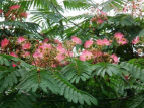

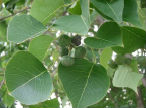
Mimosa Trees have small pink flowers attract insects and birds
All parts of the Tung Oil Tree are poisonous
Chinese Tallow Trees are used for making wax candles
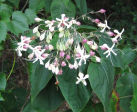
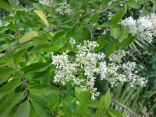
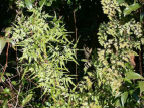
Harlequin Glory Bower are extremely aromatic flowers
Chinese Privet is a popular bonsai tree
The Japanese Climbing Fern can reach up to 90 ft in length
22 Dead Tree
30° 42. 256’ N 88°11 . 104’ W
86515, 97428
Trees are an important part of the ecosystem of the forest. Even dead trees continue to supply food and shelter for many animals. A dead tree can provide homes for birds, mammals, reptiles, and insects. Many species will dig in the soft wood to get insects for food. A decomposing tree adds nutrients to the soil which helps the growth of other plants in the area. Because of the nutrient-rich soil, young trees may grow at the base of a dead tree or fallen limb. This downed tree, known as a nurse log, offers an ideal habitat for the young trees.
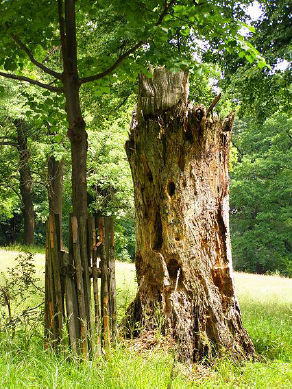
31 Fungi - Invisible Recyclers
30° 42. 138’ N 88°10 . 990’ W
86695, 97207
Fungi play an important ecological role as nature’s recyclers. Most fungi will spend their lifetime in the form of invisible cells called hyphae, feeding on dead organic matter. They capture, store, and release carbon and other nutrients that are important to the nourishment of the soil and vegetation. In times of plentiful rains and mild temperatures, hyphae will make reproductive structures, such as mushrooms. Locally, mushrooms are more frequent during late summer to early winter and can be found in many shapes and varieties.
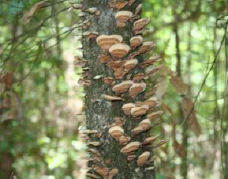
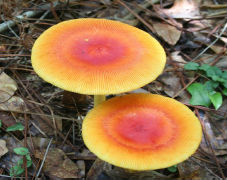
15 Greenbrier Smilax (several species)
30° 42. 116’ N 88° 11. 118’ W
86489, 97169
Greenbriers are a group of vine-like plants with over 300 species that are found throughout the world. The greenbrier family gets its scientific name, Smilax, from a Greek mythological story about forbidden love. As the story goes, a mortal man and a wood nymph fall in love. Since love between the two was forbidden, the nymph, named Smilax, was turned into a woody vine. Greenbriers are vine-like plants that climb using tendrils. Tendrils (bottom right) are thin-wiry structures on the vine’s stem that reach around until they grab hold of something. The tendrils then pull the greenbrier up. In addition to their vine-like appearance, greenbriers typically have sharp woody thorns and heart-shaped leaves.
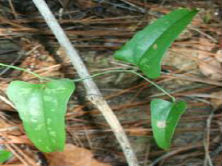
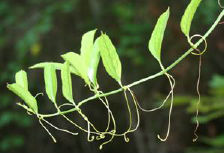
33 Souther Toads Bufo terrestris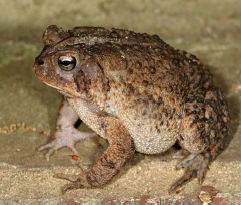
30° 42. 214 ‘N 88° 11. 099’ W
86522, 97350
The Southern Toad is a native species of the southeastern United States and is the most prominent species of toad located in this forest. It can easily be distinguished from other toads by the knobs in the area between the eyes. When seen from the right direction, they give the impression that the toad has horns. Similar to other toads, Southern toads have warty skin that is much drier than their frog cousins. The urban myth of catching warts through contact with toads is false. Two prominent bean-shaped poison glands located behind the eyes produce a milky, distasteful substance. This substance, when ingested by predators, can cause nausea and irregular heartbeat. On warm summer evenings in the South, the typical chirping sound that is often heard are these toads calling to each other while they forage for insects.
11 Deciduous vs Coniferous
30° 42. 248’ N 88°11 . 212’ W
86342, 97414
You may notice during the winter that some trees on the nature trail handle the cold months differently. Trees have two distinct shedding habits in response to the temperature stress of winter. Deciduous trees drop all of their leaves and go dormant during the cold months. Evergreen trees maintain their foliage throughout the year. They can do this because the design of their leaves allows them to endure freezing temperatures without collapsing. Common deciduous trees are yellow poplars, hickories, and maples. Evergreens include pine trees and southern magnolias. Our live oak trees are technically deciduous because they shed all of their leaves, but the new leaves come out immediately, so the tree is never really dormant.
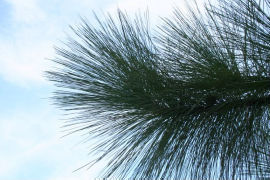
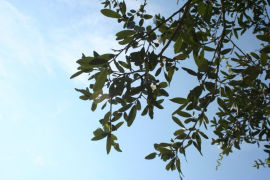
Evergreen
Deciduous
10 Sunken Trail
30° 42. 252’ N 88°11 . 386’ W
The impact of humans on the landscape are all around us. We tend to modify the environment to fit our needs by clearing forests and erecting buildings. A less obvious impact is repeated movements along the same path 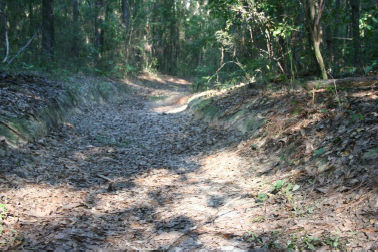 that can cause soil erosion and a “sunken road.” As we walk the trail, our feet kick off loose top soil and open up the ground to erosion. Perhaps the most famous sunken road in the southeastern United States is the Natchez Trace, which is a historic trail connecting Nashville, Tennessee, and Natchez, Mississippi. Portions of the Natchez Trace are U-shaped ravines as much as 20 feet deep. It is unlikely that any trail here would mimic the depth of the Natchez Trace. Could the high banked trail you are walking now be a result of repetitive use over hundreds of years?
that can cause soil erosion and a “sunken road.” As we walk the trail, our feet kick off loose top soil and open up the ground to erosion. Perhaps the most famous sunken road in the southeastern United States is the Natchez Trace, which is a historic trail connecting Nashville, Tennessee, and Natchez, Mississippi. Portions of the Natchez Trace are U-shaped ravines as much as 20 feet deep. It is unlikely that any trail here would mimic the depth of the Natchez Trace. Could the high banked trail you are walking now be a result of repetitive use over hundreds of years?
19 Banana Spider Nephila clavipes
30° 42. 247’ N 88°11 . 147’ W
86446, 97412
The Golden Silk Orb-Weaver is a spider species that is found heavily throughout our woods. It gets its nickname, “banana spider,” from its large curved yellow back. They are known for building very large and durable webs, which in extreme cases have been known to catch small birds. Despite their threatening outward appearance, these spiders are not aggressive and very rarely bite. Their mild venom produces a reaction similar to an ant bite. The Golden Silk Orb-Weaver is one of the largest North American spiders.
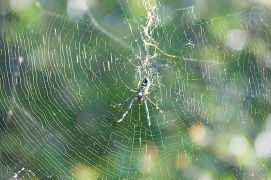
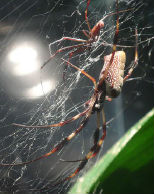
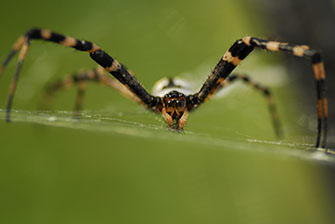
13 Those Who Came Before
30° 42. 063’ N 88°11 . 210’ W
86342 97073
The geography of the University of South Alabama campus, especially the high ground and access to water, made it an attractive place for groups of prehistoric people to camp. Archaeological evidence from these camps includes pottery shards, stone tool fragments, and stone flakes from the manufacturing of tools. Some of the archaeological sites identified in our area date to the Woodland period, and the artifacts shown here are from a Late Woodland site on campus (A.D. 800 to 1100). Prehistoric people during this time period would have established camp sites to hunt wild game and gather plants, often bringing these resources back to large village sites.
6 Young Pine Forest
30o42.056 N 88o11.281 W
As you may notice, the pine trees in front of you all appear similar in age and development. Why is this? Usually pine trees are in even aged stands based on some kind of disturbance. Something as simple as a newly cleared area will allow pine seeds to germinate and young seedlings to take root and develop. Pines need sunlight to germinate, so they do not grow well in the forest under the shade of older trees. When there is a "knockdown" of the existing vegetation by either natural or manmade causes, the full sunlight allows pine seeds to sprout and grow. The clearing of a sewer line road gave these particular pine trees the sunlight needed to prosper.
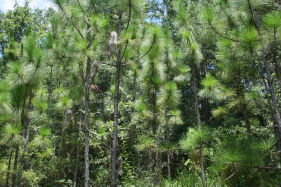
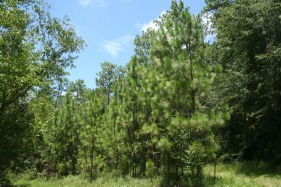
12 Turtles You Might See
30° 42. 178’ N 88°11. 206’ W
86351, 97285
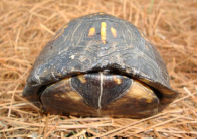
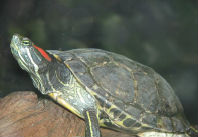
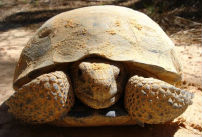
Gulf Coast Box Turtle
Terrapene carolina
- Can close up like a “box”
- Found throughout woods
- 3-7” long
- High rounded shell
- Feet not webbed or shovel-like
- Omnivore (eats anything)
Red-Eared Slider
Trachemys scripta
- Cannot close entirely
- Found near water
- 3-10” long
- Low, peaked shell
- Feet somewhat webbed
- Eats aquatic plants and animals
Gopher Tortoise
Gopherus polyphemus
- Cannot close entirely
- Found in dry sand hills
- 3-12” long
- Rounded shell
- Front legs shovel-like, hind legs elephantine
- Herbivore (eats plants)
14 Leaf Arrangement
30° 42. 128’ N 88°11 . 184’ W
86384, 97192
One of the many characteristics that botanists use to identify plants is the way the leaves are arranged on the stem. Most commonly, leaves alternate down the stem with one leaf on one side and then another leaf on the other side a little farther along. These alternate leaves can spiral around the stem or be perfectly arranged in a flat plane. When a plant has opposite leaves, two leaves are attached directly across from each other, essentially in pairs along the stem. Opposite leaves are less common than alternate leaves. Leaves can also be whorled where several leaves are attached in a circular pattern around the stem at intervals.
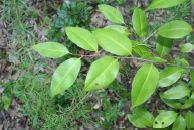
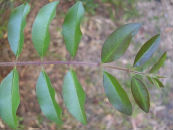
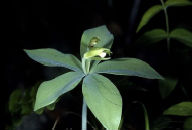
Alternate
Opposite
Whorled
7 Birds
30° 42. 111’ N, 88°11 . 346’ W
Keep your eyes peeled. The trail runs through miles of forest with many different bird species. Most birds have a diet of seeds, fruits, and insects. Birds also make nests to raise their young. Here are some common birds that you may see on the trail. Other less common birds that may be seen are eagles and hawks.
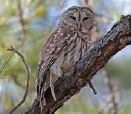


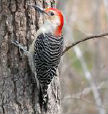
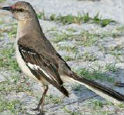
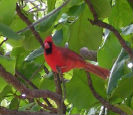
Barred Owl can rotate Neck 270° to see in different directions
Juvenile Bald Eagle has made a strong comeback in southern Alabama and is usually seen near water
Red-Tailed Hawk are easily trained and often used in falconry
Red-Bellied Woodpecker are attracted to sounds that resonate like a drum.
Mockingbird Extremely aggressive especially when defending its nest
Northern Cardinal Was once prized as a pet but domestic cardinals are now illegal
23 Mammals
30° 42. 228’ N 88°11 . 435’ W
The forest makes a great home for several types of mammals. Mammals can be found in burrows, trees, and in fields. Some of them such as raccoons, squirrels, rabbits and armadillos can be seen regularly on our trails. Others, like the opossum and the flying squirrel, are nocturnal and are seen mainly at night. Keep your eyes open for these unique mammals.
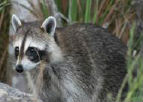
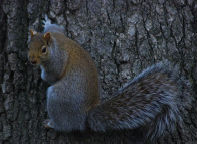
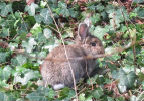
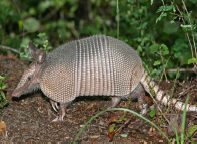
The raccoon is very intelligent and can solve and remember complex puzzles
The Grey Squirrel was introduced to Europe and displacing the native squirrel species
A rabbits ears can rotate to detect the source of sounds
Armadillo is Spanish for “Little Armored One”
18 What's Digging
33° 42. 163’ N 88°11 . 131’ W
86470, 97256
You may have noticed several locations throughout the trails where animals have been digging. The two primary reasons that animals dig holes are for shelter and food. Burrows provide shelter from the elements and protection from predators. Many animals, such as gopher tortoises, rabbits, and armadillos, live in burrows. Over its lifetime, a burrow may house numerous different species of animals. Another purpose for digging holes is to search for food. During your walk, you may notice holes right on the trail. Animals such as raccoons and armadillos often dig these in search of earth worms, grubs, and eggs.
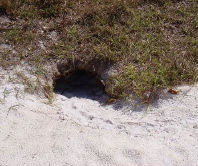
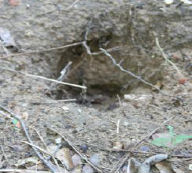
24 Dragon Fly
30° 42. 284’ N 88°10 . 974’ W
86723, 97477
Of all the insects that can be found in the woods, the dragonfly is one of the most recognized. Dragonflies have been around for more than 300 million years. Prehistoric dragon flies could reach lengths of over 2 feet. In addition to their unique appearance, they are one of the fastest insects in the world. An Australian dragonfly has been clocked at 36 miles an hour. They feed on small insects such as mosquitoes, flies, and ants. A common dragonfly that is found on the trail is the Blue Dasher. They are most prevalent from late June to October.
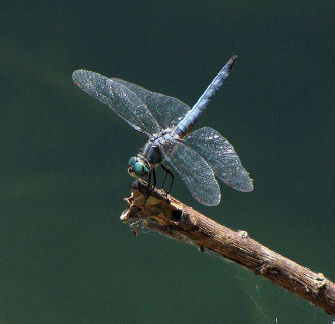
32 Longleaf Pine
30° 42. 161’ N 88°11 . 027’ W
86636, 97250
If you look around, there are several very large longleaf pines. Pine trees such as these were once used by merchants and the navy. The trunks of large longleaf pines are thick, long, and straight, making them perfect for masts on large sailing ships. Longleaf pines can live for up to 500 years and can grow to heights of over 100 feet. The largest Alabama longleaf pine, found in is just over 10 feet in circumference and 39” inches in diameter! Keep your eyes peeled for large longleaf pines on our trail and see if any of our trees can compare.
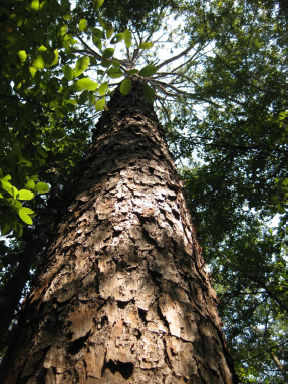
17 Monarch Butterfly
30° 42. 151’ N 88°11 . 060’ W
86583, 97232
The Monarch butterfly is one of the most recognized and unique of the North American butterflies. This species is the only butterfly that migrates north and south like a bird. During the month of August, they start migrating from their summer habitat in Canada to their winter home in Mexico, a journey of over 2000 miles. No single butterfly makes the entire trip. A monarch butterfly lives only a few months, and a typical migration can span the life cycle of three or four generations.
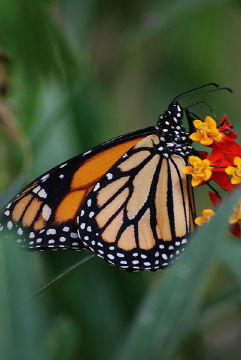
28 Plant Uses
30° 42. 237’ N 88°11. 910’ W
85228, 97406
Longleaf Pines
Masts for sailing ships
Lumber of construction
Tung Oil Tree
Wood finishing
Oil lamps
Muscadine Grape
Wine
Grapes
Sassafras
Root beer
Traditional perfume

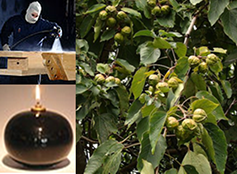
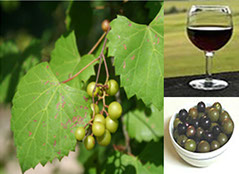
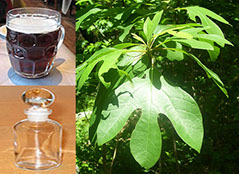
1 Common Oak Trees on the Trail
30° 42. 228’ N 88°11 . 435’ W
85986, 97381
Southern live oak (Quercus virginiana)
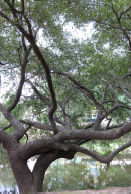
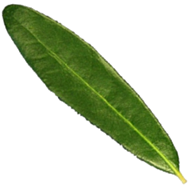
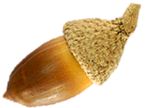

Branches reach out to side
Leaves are leathery with edges that roll under
Acorns are oblong, dark brown, shiny, edible
Bark has deep furrows
Water oak (Quercus nigra)
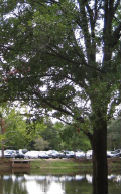

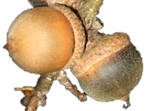

Branches reach up to sky
Leaves are flat and often broader at tip
Acorns are round, light brown, dull, inedible
Bark relatively smooth or with shallow furrows
4 Hillside Seeps Form Fearn Pond
30° 42. 026’ N, 88°11 . 149’ W
86439, 97003
Hillside seeps are formed by rainwater that percolates through a layer of permeable soil and comes to rest on an impermeable layer. In our area, the impermeable layer is usually a densely packed clay. This creates a perched water table. Permeable soil is characterized by soil particles large enough in size to allow water to seep through to a lower layer of substrate. Because the impermeable bed does not allow water to penetrate through, gravity redirects it horizontally until it breaks the surface along a hillside. Hillside seeps are common on the hills surrounding this pond, and they feed freshwater into the basin in front you.
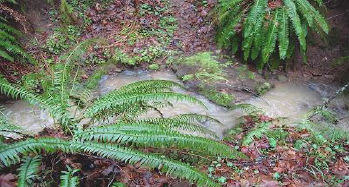
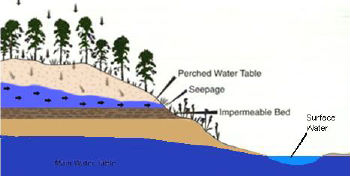
3
16 American Beautyberry (Callicarpa americana)
30° 42. 115' N 88° 11. 050’ W
86599, 97166
If insects are harassing you on your hike, try rubbing crushed leaves of the American Beautyberry on your skin. The beautyberry’s leaves are effective in repelling mosquitoes and other biting insects. The berries are also an important food source to wildlife and can be used to make jelly or wine. This plant is a native shrub up to 6-feet tall with opposite leaves 3-6” long and 1-4” wide. During the summer, small clusters of white flowers are found on the beautyberry, and in the fall, clusters of bright purple fruit form along the stems. The bright berries and white flowers make this a unique and attractive plant befitting of its name.
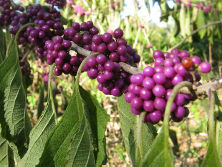
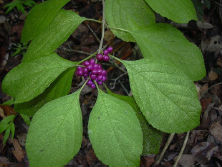

You are Here

You are Here

You are Here

You are Here

You are Here

You are Here

You are Here